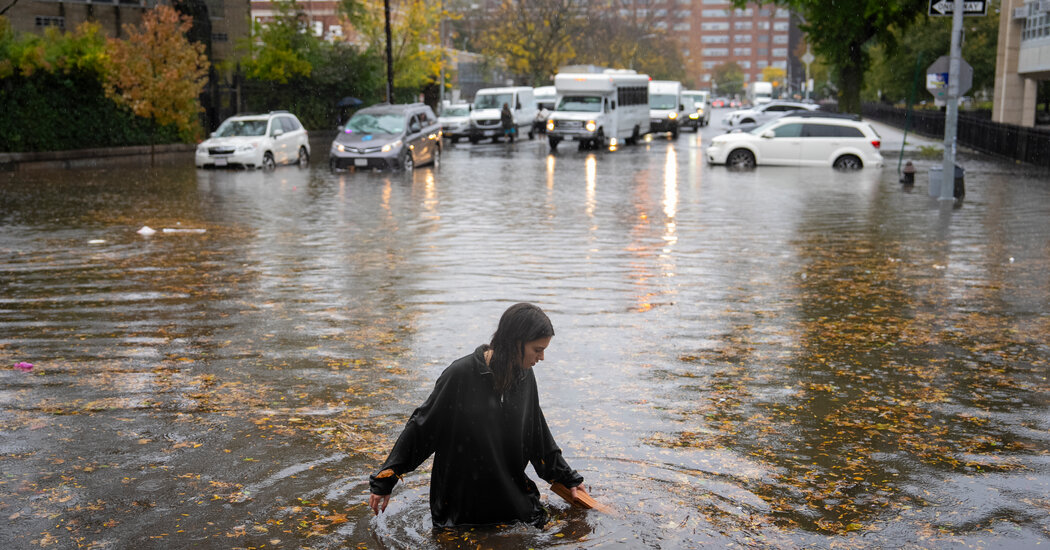Two men died on Thursday when storm water inundated basements in Brooklyn and Manhattan, as sudden heavy, record-setting rains brought flash flooding to the New York area, the police said.
One man, 39, had become trapped when he went back to his basement in the Flatbush neighborhood to rescue one of his dogs, a neighbor said. A diver pulled him out, a Fire Department spokesman said. He was taken by ambulance to Kings County Hospital, where he died. Officials did not confirm whether his death was caused by flooding.
The other man, aged 43, was found in a flooded basement boiler room of a building in Washington Heights in Manhattan. He was pronounced dead at the scene. The police did not confirm the names of either man on Thursday night.
The deaths in Brooklyn and Manhattan came as between one and three inches of rain fell across the tristate area on Thursday, according to Dominic Ramunni, a meteorologist with the National Weather Service. The downpour broke three daily rainfall records across the metropolitan area. LaGuardia Airport recorded over two inches today, with Newark Liberty International Airport and Central Park reporting 1.9 and 1.8 inches, respectively.
The rain had been predicted to fall over a period of eight hours. Instead, much of it arrived in an intense, 20-minute downpour that began at about 3:50 p.m., said Aries Dela Cruz, a spokesman for the city’s Emergency Management agency.
The deluge fell in the midst of a drought, which had left piles of fallen leaves and trash on the streets and sidewalks. The rain swept the detritus toward sewer drains, many of which became clogged.
The worst of the flooding happened between 3 and 5 p.m., according to FloodNet, an organization that monitors more than 250 flood sensors across the city. The hardest-hit areas were Flatbush and Hollis, Queens, where there were several fatalities in 2021 after the remnants of Hurricane Ida came through. Both neighborhoods experienced floodwaters that were nearly two feet deep. Bushwick, in Brooklyn, and parts of East Flushing, in Queens, were also hard hit.
The rainstorm was torrential in places. Cars were stuck in floodwaters on city streets, a spokesman for the Fire Department said, and some floated away. Flooding forced the closing of the Long Island Expressway at Springfield Boulevard in Queens in both directions, and downed trees were reported around the city.
There were scattered subway delays because of water intrusion from the street, a spokeswoman for the Metropolitan Transportation Authority said. The Long Island Rail Road experienced minor delays.
Metro-North was not affected by flooding, although downed trees caused some delays. NJ Transit reported delays of up to 30 minutes on rail lines because of high water near Newark Airport.
Amtrak temporarily paused train service around 4 p.m. at Newark Airport because of flooding, a spokeswoman said. And regional and Acela services were delayed when a tree fell in Branford, Conn. Trains are moving again in the Northeast Corridor, she added, although there are some residual delays throughout the network.
Renée Phillips, who lives next door to the man who died in Brooklyn, said he had rescued one of his dogs from the flooded basement and had then gone back to retrieve his other dog. He became trapped, she said, and both the man and his dog died.
“This day has been horrific,” Ms. Phillips said.
In other parts of the borough, the rain was a nuisance but not life-threatening. Kelly Hayes, a co-owner of the Gowanus Gardens restaurant on Fourth Avenue near Carroll Street on the Park Slope-Gowanus border, a notorious flooding spot, said she had developed a routine response to downpours. As she always does, she began to pay close attention Thursday afternoon to FloodNet.
The first indication that this storm might bring flooding were the gauges near Prospect Park, which recorded a sharp increase in rain at around 4 p.m., Ms. Hayes said. Within minutes, the water had flowed downhill to Fourth Avenue, where it covered the sidewalk. The water poured into the basement, overflowing the restaurant’s grease trap.
“We got a nice layer of slime all over our basement,” Ms. Hayes said. “It’s disgusting.”
In Bedford-Stuyvesant, Brooklyn, Andy Franklin brought his daughter to Awa Hair Braiding on Tompkins Avenue, where she wanted to get pink synthetic hair braided into her own. Awa had no pink hair in stock, so Mr. Franklin walked to another store nearby. When he returned about 10 minutes later, he found two cars floating down Tompkins Avenue in four feet of water.
The owners of Awa Hair Braiding had closed the metal security door to the shop to try to keep out the water. That meant the customers were trapped inside.
“I wanted my daughter out,” said Mr. Franklin, 35. As the downpour eased, the salon’s workers opened the gate, and Mr. Franklin retrieved his daughter.
The flooding was exacerbated by blocked sewer drains, said Leandro Fernandez, manager of the Alejandro Deli Grocery, which sits across the street from Awa Hair Braiding. Mr. Fernandez and a co-worker poked the drains with broom handles, which eventually succeeded in clearing them.
Similar work happened in the store’s basement, where an employee named Peter Putter stood for two hours in knee-deep water to clear a drain by hand. At 8 p.m., police officers and workers from the city’s Department of Environmental Protection were on the block, shoveling debris away from storm drains, Mr. Franklin said.
The storm left 1,500 residents without electricity, said a spokeswoman with the Emergency Management agency. Thunderstorms and low cloud ceilings caused arrival and departure delays at all three of the region’s major airports.
Flooding affected the entire region. In Bayonne, N.J., the police responded to cars trapped by water in underpasses around the city, said Edoardo Ferrante, coordinator of Bayonne’s Office of Emergency Management. In one incident that was recorded and posted to X, an S.U.V. became trapped under an overpass. A firefighter waded into the water, retrieved a 4-year-old-girl from the vehicle and helped the girl’s mother escape.
Although the rain has left the region, a wind advisory remains in place through Friday evening, with gusts up to 50 miles per hour, according to the National Weather Service.
Maria Cramer, Sean Piccoli and Chelsia Rose Marcius contributed reporting.
Christopher Maag is a reporter covering the New York City region for The Times.
Hilary Howard is a Times reporter covering how the New York City region is adapting to climate change and other environmental challenges.
The post 2 Men Die in Basement Flooding as Sudden Downpour Hits New York Area appeared first on New York Times.




